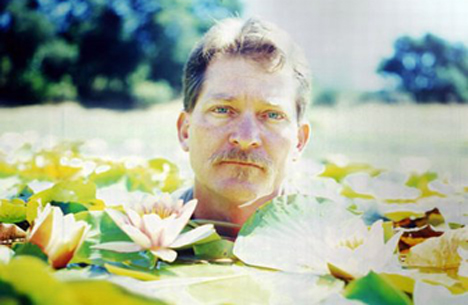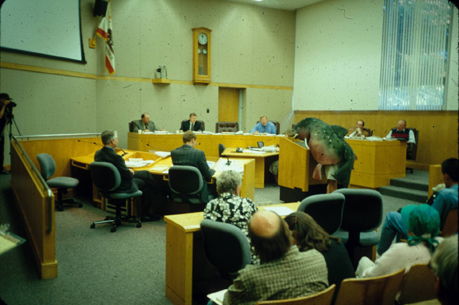Bioneers 2009: Brock Dolman’s Watershed Approach
By Bonnie Hulkower, New York, New York on 10/21/09

Photo by Jason Elon Goodman
Bioneers 2009 wasn’t your typical conference, and especially not a typical conference on climate change, which can give off an underlying feeling of doom and gloom. Bioneers represents a welcome change, as, even when dealing with the sensitive critical environmental issues of our time (sea level rise, tropical diseases, megadroughts, hypercanes, failed states) the annual conference still always somehow manages to seem upbeat. Every year the conference highlights environmental luminaries (including TH’s own Ken Rother!) and this year was no different.
Begun in 1990 by Kenny Ausubel and Nina Simmons as a forum on the environment, health, clean tech and social justice issues, this weekend was Bioneers‘ 19th anniversary and it felt like a mix between a family reunion, a college alumni event, and a rock concert.
Friday alone was packed with an all-star cast, including: Brock Dolman, Jack Hidary, Michael Pollan, and Sarah James. While other conferences may have some of these speakers, rarely are so many of them under the same roof mingling with attendees. Plus, interspersed between some of the talks were musical interludes, native, shofar-like sounding instruments, as well as a young dj Ellen spinning hip hop. The music really helped amp up the feeling we were all a part of building a positive movement.
Although the mood was upbeat, the speakers stressed that the next few years are absolutely crucial, Kenny Ausubel urged that what we need are essentially eco-SWAT teams who can be deployed in the case of an environmental emergency. These “rapid response teams” will be launched in the U.S. at the State of the World Forum in Washington, D.C. in late February 2010. The goal of the campaign is to reduce CO2 emissions 80% by 2020, not 2050.
There were almost 3,000 attendees in the auditorium and another couple of thousand streaming the conference over the internet in cities around the U.S. including Anchorage, Ithaca, Boulder, Salt Lake City, Houston, and Los Angeles. This was great because it gave the room a sense of magnitude and community that a bunch of environmental folks sitting in Marin otherwise might not have had. Nationally and globally, we need to harness the momentum to combat climate change.
It was hard not to think about the connection between climate change and water in the Bay Area this past week. Following Tuesday’s record breaking storm, which brought us 2 inches of rain and 62 miles per hour winds, Saturday was bright and sunny with temperatures in the high 60’s, and the weird weather was the talk of the town.
While other people (myself included) tried to avoid the rain and keep dry,Brock Dolman, a biologist from the Occidental Arts and Ecology Center who teaches week-long watershed workshops, embraced it. Mr. Dolman’s love of water was no secret to the audience. He has spoken at Bioneers previously, and once even dressed up as a Totem Salmon at a Sonoma County Board of Supervisor’s meeting.

Brock Dolman providing testimony photo courtesy of OAEC
Water is for the community, water is not a commodity
Mr. Dolman had recently returned from a trip to Tibet, where water is honored with prayer wheels. The U.S., Mr. Dolman feels, does not treat “planet water” nearly as respectfully as the Tibetans. Many Americans still naively buy bottled water from environmentally devastating companies. Mr. Dolman commented on this by showing the mirror image of Evian on a large screen, spelling, of course, “naïve”, and asked people to look in the mirrors and think about their water use.
Mr. Dolman peppered his talk with clever turns of phrase, some silly and many inspiring. Water, according to Mr. Dolman shouldn’t be for sale, as it is “about community not a commodity.” You don’t need to look as far as receding glaciers in Greenland to be assured that climate change is real, he asserted, you can look at the dwindling amounts of snow pack in the Sierras–mountains which are crucial to California, as they provide 80% of the state’s water supply. The next Titanic, he said, won’t be due to an iceberg crash, because there won’t be any icebergs left.
A watershed approach
So what can be done about climate change, sea level rise and potential droughts? Dolman’s solution is to seek out your watershed. With watersheds there can be no room for NIMBYism as everyone has their own backyard/watershed. He encouraged attendees to drink up and learn more about their watersheds. He even helped the county institute highway signs welcoming you to whichever watershed you were entering.
Coho salmon are indicators of water quality
“We don’t need 20-20 hindsight, we need 20-20 foresight,” Dolman announced. He believes that Coho salmon are today’s “canary in the coal mine,” as in the mid 1950’s there were thousands of Coho salmon and today there are only hundreds. Accordingly, Dolman has started a “No Coho Left Behind” campaign.
Water issues require a change in perception
For Dolman, our water problems are problems of perception. We try to send storm and waste water away, yet meanwhile there is no place such as “away.” Our motto should be: “Don’t drain, Retain!” These sound bites do make you think about your approach to water and how you can reuse it. After all, according to a Tillman quote, if you are not part of the solution, you are part of the precipitate.
To illustrate again how unique Bioneers is: when Brock finished warming up the crowd, he was given a standing ovation which did not just involve clapping but people shouting like frogs in Kermit voices, “Brrrock!! Brroock!! Broock!!” If you wanted the concert experience in San Francisco this weekend, well, you could have gone to the Treasure Island Music Festival, or you could have been inspired with the rousing speeches at Bioneers.
More on Bioneers
Michael Pollan Drinks Oil
Annie Leonard Bringing Out More Stories of More Stuff
Using Google Earth for Environmental Activism





